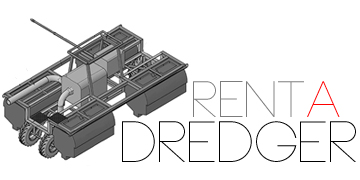How Far can the Dredge Pump?
Q1. How far can the Mini dredge transfer sediment?
This depends upon the vertical elevation differential, and the type of sediment. Our smallest mini-dredgers has a pump with a 25 m head so along our slurry pipes it can comfortably pump 100-150 m over fairly flat terrain.
It is important to maintain a minimum discharge velocity (MDV). See below.
Minimum Discharge Velocity
It is important to remember that in order to transport a slurry through a pipe or hose, it must maintain a minimum velocity to prevent the sediment from settling in the hose, eventually forming a restriction or plug.
The term for this is “minimum critical carrying velocity”.
The rule-of-thumb minimum velocity for mud and sand is 1.5 to 2.0 meters per second. We prefer to utilise a more conservative value of 2.5 meters per second.
Q2. How long will the mini-dredge pumps last?
That will depend upon the type of sediment being pumped, and how often the dredge is used.
Sand is by far more abrasive than mud, and so will wear your pump much more quickly.
The key wear components in the dredge pump are made of highly abrasion resistant materials, are designed to withstand sand abrasion, and are relatively easy to replace with new parts.
If the dredge is used for intermittent cleaning of limited areas such as boat docks, waterfront, canals and channels then one can expect a long time before the pump components wear out.
However, if you are planning to pump sand for 8 hours a day for months, then you need to consider one of our larger dredges.
Q3. Can the mini-dredge be used in salt water?
Salt water operation is fine but you will need to take extra care to flush the pumps and clean the engines with fresh water after every use.
Since the pontoon floats are made of high density polyethylene they are completely resistant to sea water, salt, chemicals, and ultraviolet light.
The pontoon frame has been fully hot-dip galvanised so that is also resistant to corrosion and sea water.
Finally the pontoons are secured to the frame with galvanised fasteners.
Q4. Can the mini dredge handle clay?
Clay can be very sticky and cohesive.
An quick way to determine whether or not your material is suitable for our dredge, is to put a lump of the clay in a glass jar of water and shake it vigorously.
If it does not completely separate in the jar, then it will problematic to get it to flow.
Q5. Will it pump leaves and seaweed?
To a point however our standard suction head has a perforated mesh strainer with 15 mm diameter holes that the material must pass through before entering the suction hose.
Leaves and seaweed will have a tendency to collect on the strainer and starve the pump.
If you have a high percentage of clumps of leaves and seaweed/seagrasses then you would be better off removing the sediment by some other method.
